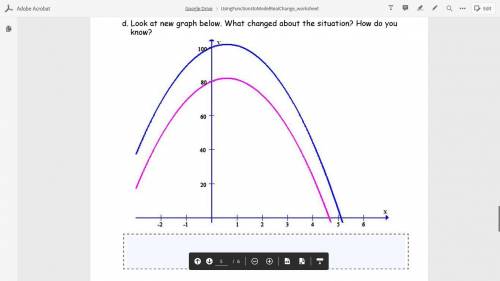
Mathematics, 20.11.2020 22:20 sierraseideman1023
A ball is thrown upward off of a 100 meter cliff with an initial velocity of 6 m/s. The function f(x)=-5x2+6x+100 (graphed below) represents this situation where x is time and y is the distance off of the ground.
e. What would the new function be? What kind of transformation is this?
f. Would you still use the same domain and range? Why or why not?


Answers: 2
Another question on Mathematics

Mathematics, 21.06.2019 23:50
Use a transformation to solve the equation. w/4 = 8 can you also leave a detailed explanation on how this equation = 32
Answers: 1

Mathematics, 22.06.2019 00:20
Submarines control how much they float or sink in the ocean by changing the volume of air and water contained in large ballast tanks. when the tanks are completely full of water, the submarine increases its overall mass and sinks down to the bottom. when the tanks are completely full of air, the submarine reduces its overall mass and floats to the surface. depending on the density of the seawater surrounding the submarine, it will pump seawater in or out of the tanks in order to achieve the same overall density as the sea water and float neutrally in the water. the volume of the submarine never changes. when the tanks are completely full of water, a submarine with a volume of 7.8\times10^3\text{ m}^37.8×10 3 m 3 7, point, 8, times, 10, start superscript, 3, end superscript, space, m, start superscript, 3, end superscript has a total mass of 8\times10^6\text{ kg}8×10 6 kg8, times, 10, start superscript, 6, end superscript, space, k, g. the density of the seawater is 10^3\text{ kg/m}^310 3 kg/m 3 10, start superscript, 3, end superscript, space, k, g, slash, m, start superscript, 3, end superscript. to make that submarine float neutrally, and neither float nor sink in the ocean, what volume of water does that submarine need to subtract from its tanks?
Answers: 1

Mathematics, 22.06.2019 02:30
Nicolo paganini's numbers 1184 and 1210 are amicable. the proper divisors of 1184 are 1, 2, 4, 8, 16, 32, 37, 74, 148, 296, and 592. the proper divisors of 1210 are 1, 2, 5, 10, 11, 22, 55, 110, 121, 242, and 605. use the definition of amicable (friendly) numbers to show that they are indeed amicable. which of the folowing statement uses the definition of amicable numbers to show that 1184 and 1210 are indeed amicable? o a. o b. ° c. the sum of proper divisors of 1184 is 1210 and the sum of proper divisors of 1210 is 1184 the sum of proper divisors of 1184 is greater than 1210 and the sum of proper divisors of 1210 is greater than 1184 the sum of proper divisors of 1184 is less than 1210 and the sum of proper divisors of 1210 is less than 1184
Answers: 1

Mathematics, 22.06.2019 03:00
Harold wrote this equation to model the level of water in a pool over time. the variable x represents time in hours. f(x) = 3,500 - 225x which statements about the situation are true? check all that apply. the water level is rising. the water level is falling. the initial level of water in the pool was 3,500 units. the initial level of water in the pool was 225 units. the pool was empty after 14 hours. the water was 2,600 units high after 4 hours.
Answers: 2
You know the right answer?
A ball is thrown upward off of a 100 meter cliff with an initial velocity of 6 m/s. The function f(x...
Questions



Mathematics, 04.03.2021 18:10

Mathematics, 04.03.2021 18:10

Chemistry, 04.03.2021 18:10

English, 04.03.2021 18:10

Mathematics, 04.03.2021 18:10

Mathematics, 04.03.2021 18:10


History, 04.03.2021 18:10



Mathematics, 04.03.2021 18:10



Mathematics, 04.03.2021 18:10



Mathematics, 04.03.2021 18:10



